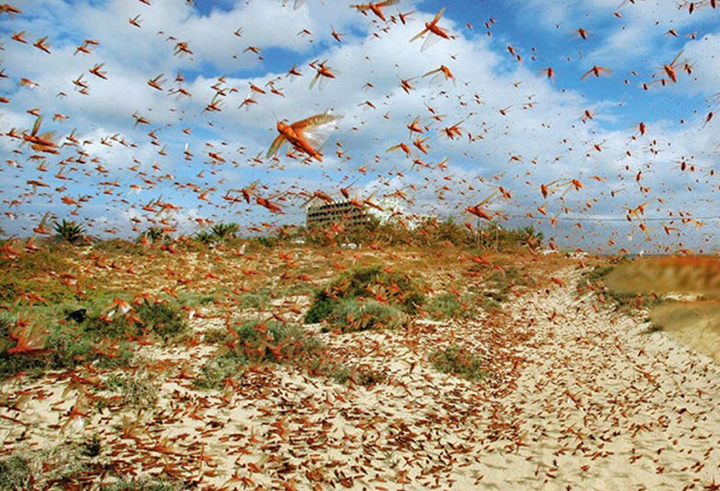Farmers of Madhya Pradesh stood watching helplessly as swarms of locusts consumed their standing crop of maize, vegetables and pulses
India is now facing the worst desert locust attack. The Centre has issued warnings to 12 states. So far, the pest has destroyed crops in five states — Rajasthan, Madhya Pradesh, Uttar Pradesh, Gujarat and Maharashtra.
Due to Cyclone Amphan, the Food and Agricultural Organisation (FAO) has warned about the eastward spread of locusts. “Several successive waves of invasions can be expected until July in Rajasthan with eastward surges across northern India as far as Bihar and Odisha followed by westward movements and a return to Rajasthan on the changing winds associated with the monsoon. These movements will cease as swarms begin to breed and become less mobile. Swarms are less likely to reach south India, Nepal, and Bangladesh,” FAO says on its website. But it has hit some parts of Andhra Pradesh and Tamil Nadu and destroyed banana and rubber crops.
The desert locusts entered Madhya Pradesh in end-May 2020 and have covered 40-55 districts in the state. In Shivpuri district, locusts have destroyed crops worth millions. On 30-31 May, they attacked many villages in the Bairad region and ate up vegetable and maize crops in Kemai, Jariya, Jorai villages.
Farmers of these regions said that they rushed to their farms when they saw lakhs of this locust swarming toward their village and created noise to chase them away. “When we saw locusts entering, we right away reached our fields with utensils, cow bells. Nobody warned us about them. We haven’t seen such locusts in our entire life, they destroyed our vegetable and even mango crop within hours,” said Chandan Rawat, a farmer.
Locusts have attacked the standing moong crop in Shivpuri. Scientists are saying if the swarm of locusts is not controlled, it can destroy the standing pulse crop in Madhya Pradesh worth Rs 8,000 crore.
Similar to various parts of the country where locusts have created havoc, Shivpuri too was busy tackling Covid-19 when the locust swarms arrived. CS Thakur, an agriculture officer in Shivpuri district, told the media that the administration has been spraying insecticides to kill locusts and also issued warnings to many villages. The administration is doing the best it can, he claimed.
On 29 May, the State agriculture department undertook control operations in five districts: Satna, Balaghat, Niwari, Raisen and Shivpuri. Authorities are saying that for effective locust control, fire brigades were rushed to spray pesticide. Hand-held spray equipment has been deployed. The agriculture department has directed district authorities to spray insecticide in the morning.
This is the worst locust attack in three decades and experts believe that the excess rain in northwest and central India helped them breed and reproduce, as moisture provides the best condition for locusts to breed and this year has been warm so far. This moisture seems to have been generated from westerly disturbances by storms carrying moisture in the upper atmosphere from the Atlantic and the Mediterranean.
Keith Cressman, senior locust forecasting officer with the Food and Agriculture Organisation in an Interview with Down to Earth magazine in February warned against locust attack. He said that wind pattern change in India and Pakistan and frequent cyclones due to climate change has created the best conditions for locusts to breed and migrate at the start of monsoon.
Locusts are short-horned grasshoppers and the species attacking parts of Africa and Asia is Schistocerca gregaria. Locusts can readily change their colour according to circumstances. Locusts are generally solitary creatures but when provided with the right weather condition – that is moisture, they breed. When their number increases and they start living in close company, these locusts become gregarious. They start traveling in large numbers, eating almost everything green in their way.
The Indian Ocean dipole, a pattern of temperature change in Indian Ocean, is being considered by scientists as a reason behind the current population explosion as it affected rainfall particularly in east Africa and the Middle East.
Clearly, the world is facing the wrath of nature. After Covid-19, locust attack is creating a threat to food security, a result of climate change. Governments must understand that time has come for human civilisation to reflect upon such a crisis and plan for survival. Such crises are borderless and required better cooperation among states otherwise suffering will keep on increasing.





